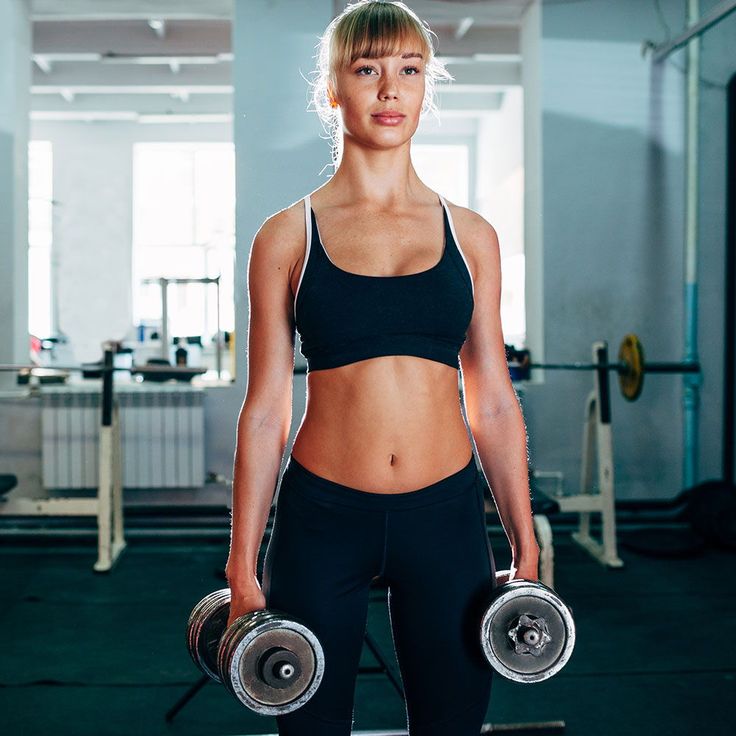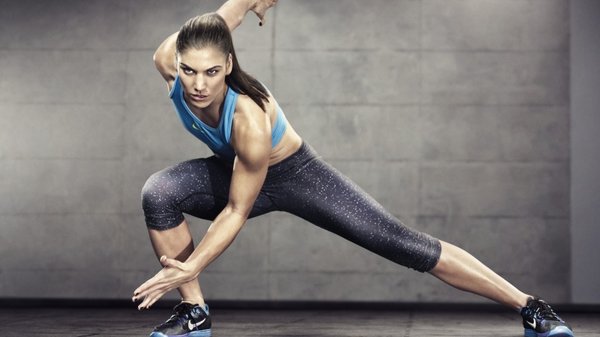Circuit training – principles, examples of programs for the gym and at home
Circular training is a method of organizing sports activities aimed at increasing endurance and burning subcutaneous fat. This is an intense exercise with minimal pauses, in a circle. Cyclic training is conducted in bodybuilding, fitness, martial arts, workout, crossfit, aerobics, plyometrics.
Circular Training Principles
It is not enough to choose a set of exercises. To build an effective whole-body workout, you must adhere to the following rules:
- A mandatory warm-up is carried out before the lesson.
- 1-2 training elements are selected for each muscle group.
- Set for the time or number of repetitions (usually 30 seconds or 15-20 reps).
- Pause between sets – 5 to 30 seconds, break between circles – 3-5 minutes.
- The number of elements performed in a row is 6-10, the number of circles is 2-3.
- Alternating exercises for the lower body and for the upper body.
- Weight increases gradually with each subsequent cycle.
- Exercises are selected so as to cover large muscle groups as much as possible.
- Number of workouts per week: 3-4 – for trained athletes, no more than 2 for beginners .
If it’s hard to perform basic strength elements – squat, bench press, deadlift – with free weights We recommend using a Smith machine.
Intensity
Cyclic training for all muscle groups can be performed using three main methods:
- Low intensity. Based on simple exercises performed at a comfortable pace for the athlete. The pauses between approaches are maximum (25-30 seconds). This mode helps to improve physical fitness and maintain the health of the cardiovascular and respiratory systems.
- Medium Intensity . It is characterized by a combination of strength and aerobic exercise. The pace is average, slightly higher than the comfortable one, the pauses are 15–20 seconds. It is allowed to increase the weights with each round. The technique allows you to develop endurance, train the heart and burn subcutaneous fat.
- High intensity . It assumes an almost complete reduction in pauses between elements and an increase in the pace of execution to 80-90% of the maximum. This training method helps to form a beautiful contoured muscle relief and “dry” the body. Not suitable for untrained athletes due to severe heart stress.
People who have never played sports are advised to start with low intensity activities. After 2-3 months of regular training, you can increase the intensity, or switch to classic fitness.

Advantages and disadvantages
First, let’s look at the positive aspects of cyclic training:
- Rapid reduction of body fat. Firstly, circular exercises combine strength and aerobic activity, which has a positive effect on weight loss. Secondly, thanks to this combination, metabolic processes are accelerated, which helps an athlete to lose weight not only during training, but also during recovery periods.
- Working out the muscle frame. A wide variety of elements allows you to harmoniously strengthen the muscles of the whole body, forming a solid foundation for subsequent strength training.
- Development of mobility. An intense pace of exercise and a combination of various loads help to strengthen the ligaments, tendons, as well as improve the extensibility of the vertebrae and joints. Thanks to this, the athlete can increase speed performance.
- Increase endurance. During low- and medium-intensity cyclic training, the myocardium, the main heart muscle, is strengthened, which helps to develop overall endurance.
Consider the disadvantages of circuit training:
- No clear pronounced specialization. Cyclic training develops the body’s resistance to stress and reduces body fat. But such activities will never make a person a bodybuilder, powerlifter or athlete. The most that you can count on is a figure tightening and general muscle strengthening.
- Strong stress on the heart. Observed with the high-intensity circular training method. Some scientists speak out directly against such disciplines, as extreme loads “acidify” muscle fibers, which can be very dangerous for the heart.
To protect the cardiovascular system, we recommend starting with the simplest elements, performed at a low pace.
Warm up section
At the beginning of each round workout warm up. This will help prepare the body for intense exercise. As an example, let’s analyze the following complex:
- We stand up straight and begin to move vigorously on our toes, imitating an easy run, but without taking our feet off the floor. At the same time, we bend our arms, squeeze the hands into a lock and begin to rotate them in different directions. We move like this for 30 seconds.
- Stop. We stretch our arms in front of us and perform rotations in the elbow joints (forward and backward). We continue for 30 seconds. Then we spread our arms to the sides and again rotate the forearms in different directions for 30 seconds.
- Slightly tilt the body forward, place our feet slightly wider than shoulders, bend our arms and run in place. We raise our feet low. We move vigorously for half a minute.
- From the “standing” position, take the leg back. We push it off the floor and raise the knee in front of us to the parallel of the thigh with the floor. We immediately take the leg back. We move energetically, without pauses. We carry out 20 knee pushups on each side.
- We spread the feet wide (70-80 cm). We cross our palms at the chest. We shift the weight of the body to the left, slightly sit down on our feet and overwhelm with the right shin. We quickly return to the starting stance and repeat in the other direction. Move for 30 seconds.
- Stay with feet wide apart. Now, instead of overlaps, we perform alternating knee lifts. At the same time, we pull the opposite elbow to the raised knee joint. Before lifting the hips, we sit down slightly on our legs. Continue for half a minute.
Finally, inhale deeply and stretch your arms up, standing on your toes. We repeat 4-5 times. Warm up at an even pace, without pauses between exercises.
Training programs
Use the suggested options as a guide.
In the gym
An example of a circle session:
- Pull-ups. We grab the horizontal bar with a straight grip and perform 10 pull-ups, then change the grip to the opposite one and pull up another 10 times.
- Medball push-ups. We accept the emphasis lying down, put our right palm on the medball. We lower the body, then raise and change the position of the hands: the right one is on the floor, the left one is on the ball. Push up from this position.
- Side jumps. We stand sideways to the horizontal bench. We push off with our feet and jump over it. Reverse jump immediately.
- Bench press. We lie with our backs on the bench, put our feet firmly on the floor. Grab the bar with a medium grip and perform vigorous chest presses. Avoid hitting in the bottom position. We select the warm-up weight in order to fully complete the approach.
- Kettlebell lifts. We stand up straight, legs spread wide. We take one kettlebell in our hands, hold it at the groin level. We inhale, sit down a little on our feet and swing the weight over our head with a swing motion. Do not bend your arms. As you inhale, straighten your legs and lower your weight.
- Burpee. From a vertical position, we abruptly squat down and press our palms to the floor next to the feet. We quickly “jump” back, thereby assuming the position of the plank. We push up from the floor. With a jerk, we pull the hips to the stomach and jump up as high as possible. Go down and repeat all movements.
- Press squats. We stand up straight, take dumbbells in our hands and raise them to shoulder level. Squat deep, stand up and squeeze the weight over your head.
- “Transitions” on the arms. We descend into the classic lying position. We put one elbow on the floor, then the second. We repeat in the reverse order. We move energetically, without pauses. When doing it, keep the lower back straight, avoid bending and sagging.
- Jumping onto the plio box. We choose a high platform (60–70 cm). We perform vigorous jumping.
- Raising the hips to the press. We approach the Swedish wall, press against it with our backs and perform hanging on the crossbar. Without lifting the lower back from the projectile, simultaneously raise the hips to parallel with the floor. Do not bend your knees.
The duration of the exercises (except for the first one) is 20 seconds each. The pause between elements is 5-10 seconds. We repeat the circle at least three times. Break between circles – 4-5 minutes.

At home conditions
An example of a training plan:
- Jumping from a deep squat. We stand up straight, abruptly drop into a deep squat and jump out as high as possible with a powerful push. During the jump, stretch your arms up.
- Deadweight with kettlebell. If you don’t have a kettlebell, you can use a backpack full of books. We spread our feet slightly wider than the shoulders and take the load in our hands. We take the pelvis back and bend forward a little. The weight should drop to the floor. From the bottom point, we immediately begin to unbend the legs and straighten the body. Keep the lower back arched during execution.
- Jumping lunges. We stand in a right-sided lunge. With a jerk, we jump low and change the position of our legs in the air. We land on a left lunge.
- Push-ups. We accept an emphasis lying down and spread our arms wide. Push up vigorously. When performing, keep the body straight, do not lower the head.
- Jumping in place. We stand up straight, push off with our feet and pull our knees up. We jump vigorously, without pauses.
- Reverse push-ups. We turn our backs to two chairs, lower ourselves and press our palms against them. We stretch our legs in front of us, bring our feet together. We perform push-ups from this position.
- Rises on the press. We lie down on the floor, bend our knees, fix our feet under a sofa or armchair. We cross our arms at the back of the head. We carry out lifts of the body to the knees.
- Jumping in the bar. We get into the plank position. With a jumping movement, we sharply pull both knees towards us. Reverse jump “throw” the hips back.
- Push-ups with raising the arm. We go down to the lying position. Keeping your back straight, we push up from the floor. In the upper phase, we extend our hand in front of us. On the next lift, extend the other hand.
- Side crunches. We lie on our back, bend our legs and put our feet on the floor. We put our palms on the back of the head. As you exhale, we twist to the right and pull the left elbow to the side. Then repeat twisting in the opposite direction.
The duration of each exercise is half a minute, pauses are 10-15 seconds. We carry out 3-4 circular cycles. Break between circles – 3 minutes.
Contraindications
Medical restrictions for circular training:
- unhealed injuries and sprains;
- disruption of the vestibular apparatus;
- diseases of the cardiovascular and respiratory systems;
- the first 3 months after childbirth;
- pathology of the musculoskeletal system;
- the recovery period after surgery.
Before starting training, we recommend that you visit a doctor to identify abnormalities in health. If you are working with a personal instructor, be sure to provide him with the results of a medical examination. Based on this, the specialist will create an individual program that is most adapted for you.


